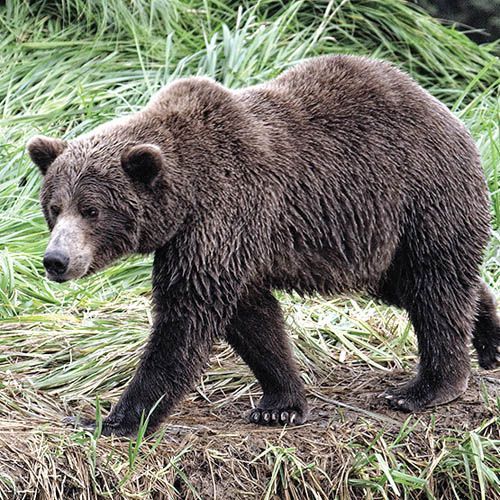Bears captivate with their strength, intelligence, and diverse habitats. These majestic animals roam forests, mountains, and Arctic regions.
Bears belong to the family Ursidae and include species like the grizzly, polar, and panda bear. They play crucial roles in their ecosystems, from seed dispersal to population control of other species. Despite their fearsome reputation, bears are often solitary and avoid human contact.
Conservation efforts are vital to protect their habitats and ensure their survival. Understanding bear behavior and ecology helps in promoting peaceful coexistence with these fascinating creatures. Whether foraging for berries or hunting for fish, bears exhibit remarkable adaptability and resilience in the wild.
The Majesty Of Bears: An Introduction
Bears are majestic animals. They roam forests and mountains. These creatures inspire awe and wonder. Bears have thick fur and powerful limbs. They symbolize strength and resilience.
Many people find bears fascinating. They appear in stories and myths. Bears also hold cultural significance. Let’s explore their world together.
Myths And Legends
Bears often feature in myths and legends. In many tales, they are wise and strong. Some stories depict them as protectors. Others show them as fierce warriors.
These myths teach us lessons. They highlight the bear’s power. They also show its gentle side. Bears are complex and intriguing.
Significance In Various Cultures
Bears are important in many cultures. Native Americans revere them. They see bears as spiritual guides. In Asian cultures, bears symbolize bravery.
In European folklore, bears are noble. They often represent kings and heroes. Each culture has its own bear stories.
| Culture | Bear Symbolism |
|---|---|
| Native American | Spiritual guides |
| Asian | Bravery |
| European | Nobility |
- Bears are wise in myths.
- They symbolize strength and resilience.
- Each culture views bears uniquely.
- Explore bear myths.
- Learn about cultural significance.
- Appreciate their majestic nature.

Credit: rangerrick.org
Species Spotlight: Diversity Among Bears
Bears are majestic creatures. Their diversity is truly fascinating. Each species has unique traits and habitats. Let’s explore some of the most interesting bear species.
Polar Bears: Arctic Giants
Polar bears are the giants of the Arctic. They are strong swimmers. Their white fur blends with the snow. They hunt seals on sea ice. Their large paws help them walk on ice. They can smell prey from miles away. Polar bears are the largest bear species.
| Feature | Description |
|---|---|
| Habitat | Arctic regions |
| Diet | Seals, fish |
| Size | Up to 1,500 pounds |
Grizzlies: The Mountain Monarchs
Grizzly bears roam the mountains and forests. They have a hump on their shoulders. This hump is made of strong muscles. It helps them dig and climb. Grizzlies have long, sharp claws. These claws are perfect for catching fish. They also eat berries, plants, and small animals. Grizzlies are very powerful and can run fast.
- Habitat: North American mountains and forests
- Diet: Fish, berries, plants, small animals
- Size: Up to 1,200 pounds
Each bear species is unique and fascinating. Their diversity makes them special and important to nature.
Bear Habitats: From Ice To Forest
Bears are found in diverse habitats around the world. They thrive in icy tundras and dense forests. Each species adapts to its unique environment.
Adapting To Extremes
Polar bears live in the Arctic. They have thick fur and fat layers for warmth. They swim long distances to find food. Grizzly bears roam forests and mountains. They have long claws for digging and climbing. They hibernate in winter to conserve energy.
| Bear Species | Habitat | Adaptations |
|---|---|---|
| Polar Bear | Arctic | Thick fur, fat layers, swimming ability |
| Grizzly Bear | Forests and mountains | Long claws, hibernation |
| Panda Bear | Bamboo forests | Strong jaws, bamboo diet |
Human Impact On Bear Environments
Humans affect bear habitats. Deforestation reduces forest areas. Climate change melts Arctic ice. Bears struggle to find food and shelter.
- Deforestation: Bears lose trees and shelter.
- Climate change: Melting ice threatens polar bears.
- Urbanization: Bears face dangers near cities.
Protecting bear habitats is crucial. It ensures their survival and balance in nature.
Bear Behavior: Solitude And Sociability
Bears are fascinating creatures with unique behaviors. They balance between solitude and sociability. This blog post explores their communication and interaction. It also discusses their solitary nature.
Communication And Interaction
Bears communicate in many ways. They use vocal sounds, body language, and scent marking. Grunts, growls, and roars are common vocal sounds. These sounds help them express different emotions.
Body language is another key method. Bears stand on their hind legs to show dominance. They also use facial expressions to convey feelings.
Scent marking is crucial for bears. They rub their bodies against trees. This leaves their scent and marks their territory. It helps them avoid conflicts with other bears.
The Solitary Nature Of Bears
Most bears prefer to be alone. They are solitary animals. They spend most of their lives in isolation. They only come together for mating and raising cubs.
During mating season, male bears search for females. After mating, they go back to their solitary lives. Female bears raise cubs alone. They care for them until they are old enough to survive on their own.
Solitude helps bears find food more easily. It reduces competition and ensures survival. They roam large territories in search of food. Being alone allows them to cover more ground.
| Communication Method | Purpose |
|---|---|
| Vocal Sounds | Express emotions |
| Body Language | Show dominance or submission |
| Scent Marking | Mark territory |
Diet Of The Mighty: What Bears Eat
Bears are fascinating creatures with diverse dietary habits. They eat a variety of foods depending on their species and habitat. Understanding their diet helps us appreciate their adaptability and survival skills.
Omnivorous Appetites
Most bears are omnivores. This means they eat both plants and animals. Their diet can include fruits, nuts, insects, fish, and small mammals.
- Fruits: Bears love berries, apples, and other fruits.
- Nuts: They consume acorns and other nuts for energy.
- Insects: Ants, bees, and beetles are common in their diet.
- Fish: Salmon is a favorite for many bear species.
- Small Mammals: They hunt rodents and other small creatures.
Each bear’s diet varies based on their environment and food availability.
Seasonal Feeding Habits
Bears adjust their diet with the changing seasons. In spring, they eat fresh shoots and plants. This helps them regain strength after hibernation.
| Season | Diet |
|---|---|
| Spring | Fresh shoots, plants, insects |
| Summer | Fruits, nuts, fish |
| Fall | High-fat foods, preparing for hibernation |
| Winter | Hibernation, minimal eating |
During summer, bears feast on fruits, nuts, and fish. These foods provide the energy needed for their active lifestyle.
In fall, they focus on high-fat foods to prepare for hibernation. This is crucial for their survival during the long winter months.

Credit: www.amazon.com
Reproduction And Lifecycle
Bears are fascinating creatures with complex reproductive and lifecycle patterns. Understanding their lifecycle helps appreciate their survival skills and family dynamics. Let’s dive into how bears reproduce and raise their cubs.
Cub Rearing And Family Dynamics
Bear cubs are usually born during the mother’s hibernation period. The mother bear gives birth in the safety of her den. Cubs are born blind and helpless. They rely entirely on their mother for warmth and nutrition.
Mother bears are extremely protective of their cubs. They teach them essential survival skills. Cubs learn how to find food, climb trees, and avoid danger. The family bond is strong, with cubs staying with their mother for up to two years.
During this time, the mother ensures the cubs grow healthy and strong. She leads them to rich feeding grounds and teaches them to hunt and forage. The cubs mimic the mother’s actions, learning through observation.
Survival And Maturity
Survival is a challenging journey for bear cubs. They face threats from predators, starvation, and harsh weather. Only the strongest cubs make it to adulthood. The mother’s guidance is crucial during the early months.
As the cubs grow, they become more independent. By the age of two, they are ready to leave their mother. The young bears venture out to establish their own territory. This is a critical period for their survival.
Bear cubs reach maturity at different ages depending on the species. For example, grizzly bears mature around 4-6 years, while polar bears take longer, around 5-6 years. Reaching maturity means they are ready to reproduce and continue the cycle.
Understanding the reproduction and lifecycle of bears sheds light on their resilience and adaptability. These majestic animals continue to thrive in diverse environments around the world.
Conservation Efforts: Protecting Bear Populations
Bears are vital to our ecosystem. These majestic creatures face numerous challenges. Conservation efforts aim to protect bear populations and their habitats. Dedicated organizations work tirelessly to ensure their survival. Let’s explore the various threats and success stories in bear conservation.
Threats To Bear Survival
Bears face many threats in the wild. Habitat destruction is a major concern. Human activities like logging and mining destroy bear habitats. Climate change also affects their environment. Warmer temperatures reduce food availability. Poaching and illegal hunting threaten bear populations. Bears are hunted for their fur and body parts. These threats put many bear species at risk.
| Threat | Impact |
|---|---|
| Habitat Destruction | Loss of home and food sources |
| Climate Change | Reduced food availability |
| Poaching | Decreased populations |
Success Stories In Conservation
Despite challenges, there are many success stories. Conservation programs have made significant progress. Protected areas help safeguard bear habitats. National parks and reserves provide safe spaces for bears. Anti-poaching laws reduce illegal hunting. Strict enforcement helps protect bear populations.
Community involvement plays a crucial role. Local communities help monitor bear movements. Education programs raise awareness about bear conservation. People learn to coexist with these magnificent animals. These efforts contribute to the success of conservation programs.
- Protected Areas
- Anti-Poaching Laws
- Community Involvement
- Education Programs
There is hope for the future. Continued efforts are essential. With global support, we can secure a better future for bears. Together, we can ensure these majestic animals thrive.
Encounters With Bears: Safety And Respect
Encountering a bear in the wild is both thrilling and dangerous. It’s essential to understand how to stay safe while respecting these majestic animals. Knowing how to behave in bear country ensures your safety and the bear’s well-being.
Best Practices In Bear Country
When in bear country, there are key practices to follow:
- Stay Alert: Always be aware of your surroundings.
- Make Noise: Talk, sing, or clap to avoid surprising a bear.
- Travel in Groups: Bears are less likely to approach groups.
- Store Food Properly: Use bear-proof containers or hang food high.
In case of an encounter, follow these steps:
- Stay Calm: Do not run. Move slowly and speak softly.
- Identify Yourself: Let the bear know you are human by waving your arms.<

Credit: www.crittercarewildlife.org
Frequently Asked Questions
What Are The Different Types Of Bears?
There are eight bear species. They include the polar bear, brown bear, black bear, and panda. Each species has unique characteristics and habitats.
Where Do Bears Typically Live?
Bears inhabit diverse regions, from forests and mountains to the Arctic. They adapt to various environments, finding food and shelter in each.
What Do Bears Eat?
Bears have varied diets. They eat plants, fruits, insects, and fish. Some, like polar bears, primarily hunt seals.
How Do Bears Hibernate?
During hibernation, bears slow their metabolism, lowering body temperature and heart rate. They survive on stored body fat.
Conclusion
Bears captivate us with their strength and beauty. Understanding them helps preserve their natural habitats. By protecting bears, we ensure a balanced ecosystem. These majestic animals deserve our respect and care. Continue to explore and support conservation efforts. The world of bears is truly fascinating and worth safeguarding.











